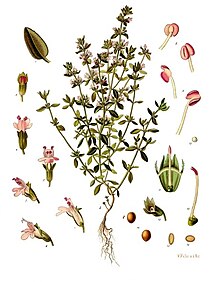Real thyme
| Real thyme | ||||||||||||
|---|---|---|---|---|---|---|---|---|---|---|---|---|

Common thyme ( Thymus vulgaris ) |
||||||||||||
| Systematics | ||||||||||||
|
||||||||||||
| Scientific name | ||||||||||||
| Thymus vulgaris | ||||||||||||
| L. |
Real thyme ( Thymus vulgaris ), also known as Roman quendel , tripe or garden thyme , is a species of thyme ( Thymus ) within the mint family (Lamiaceae). It is used as a medicinal and aromatic plant.
description
Vegetative characteristics
The real thyme is a perennial , heavily branched subshrub that reaches heights of 10 to 40 centimeters. The branches are prostrate or ascending, square, woody and hairy short. The cross-opposite leaves are sessile or short-stalked and narrowly elliptical. Its upper side is gray-green in color, the underside is hairy gray-white and the edge is rolled back.
Generative characteristics
The small flowers are arranged in pseudo whorls, which are located in cylindrical heads at the ends of the branches. The hermaphrodite flowers are zygomorphic and five-fold with a double flower envelope . The five petals are white or pink and fused to form a two-lipped crown. The upper lip is not bell-shaped, the lower lip has three broad lobes. The nut fruits are spherical.
The flowering period extends from May to October.
The number of chromosomes is 2n = 30.
Occurrence
The real thyme originally comes from the western European Mediterranean region . It is used as a medicinal and aromatic plant and only grows wild in Central Europe in warm areas, especially at the southern foot of the Alps and in southwestern Switzerland. He was naturalized in several places in Germany .
It populates gaps in dry grass and maquis . The real thyme thrives best on dry, shallow, stony, calcareous soils in an extremely hot summer climate .
Systematics
One can distinguish the following subspecies:
- Thymus vulgaris subsp. aestivus (Reut. ex Willk.) A.Bolòs & O.Bolòs : It occurs in eastern Spain and the Balearic Islands .
- Thymus vulgaris subsp. mansanetianus P.P. Ferrer , A.Navarro, E. Laguna & Mateo : This subspecies, which was first described in 2013, occurs in eastern Spain.
- Thymus vulgaris subsp. vulgaris : It is native to Spain, France and southeastern Italy, but occurs as a neophyte in Central Europe, Algeria, New Zealand and Central America.
ingredients
There are six defined chemotypes of real thyme. The distribution and frequency of the individual chemotypes within a herd depends in particular on genetic and climatic conditions. The composition of the essential oils of the chemotypes is different, they are named after their main component. The types are:
- The geraniol chemotype
- The linalool chemotype
- The α-terpineol chemotype
- The trans -Thuyanol-4-terpineol-4 chemotype
- The carvacrol chemotype
- The thymol chemotype
use
Thyme as a medicinal plant
Historically, thyme is mentioned in antiquity by Pliny and in the Middle Ages (12th century) by Hildegard von Bingen . Real thyme is officinal , it was voted Medicinal Plant of the Year 2006.
The medicinal use of essential thyme oil has been recognized as a valuable ingredient by Commission E against catarrh of the upper respiratory tract, bronchitis and whooping cough . Essential thyme oil has been shown to have anti- bacterial and anti- viral effects in laboratory tests , but clinical studies on its effectiveness are lacking.
Thyme as a bee pasture
The real thyme is a very good bee pasture . On an area of one hectare passed with it, a honey yield of 125 to 185 kg per flowering season can result.
Thyme as a spice plant
The real thyme is an important aromatic plant . It can be used fresh as well as dried in soups , stews , fish and meat dishes as well as sausages .
literature
- Klaus Becker, Stefan John: Color atlas useful plants in Central Europe . Eugen Ulmer, Stuttgart (Hohenheim) 2000, ISBN 3-8001-4134-5 .
Web links
- Real thyme. In: FloraWeb.de.
- Real thyme . In: BiolFlor, the database of biological-ecological characteristics of the flora of Germany.
- Thymus vulgaris L. In: Info Flora , the national data and information center for Swiss flora . Retrieved February 24, 2016.
- Thomas Meyer: Thyme data sheet with identification key and photos at Flora-de: Flora von Deutschland (old name of the website: Flowers in Swabia )
- Information on real thyme. (PDF file; 254 kB)
- Information from NABU.
- Profile of the Maria Laach Monastery Nursery (PDF; 224 kB)
- Thyme as a medicinal plant.
Individual evidence
- ^ Erich Oberdorfer : Plant-sociological excursion flora for Germany and neighboring areas . With the collaboration of Angelika Schwabe and Theo Müller. 8th, heavily revised and expanded edition. Eugen Ulmer, Stuttgart (Hohenheim) 2001, ISBN 3-8001-3131-5 , pp. 814 .
- ↑ a b Dietmar Aichele, Heinz-Werner Schwegler: The flowering plants of Central Europe . 2nd Edition. tape 4 : Nightshade plants to daisy plants . Franckh-Kosmos, Stuttgart 2000, ISBN 3-440-08048-X .
- ↑ a b c d Rafaël Govaerts (Ed.): Thymus vulgaris. In: World Checklist of Selected Plant Families (WCSP) - The Board of Trustees of the Royal Botanic Gardens, Kew . Retrieved February 24, 2016.
- ^ R. Granger, J. Passet: Thymus vulgaris spontane de France: races chimiques et chemotaxonomie. In: Phytochemistry . Volume 12, No. 7, 1973, pp. 1683-1691, DOI: 10.1016 / 0031-9422 (73) 80388-7 .
- ↑ Phytodoc: Information on the medicinal plant real thyme, areas of application and mode of action, online , accessed on March 5, 2009
- ↑ Phytodoc: Information on the medicinal plant Echter Thyme, introduction, online , accessed on March 5, 2009
- ↑ Josef Lipp et al .: Handbook of Apiculture - The Honey. 3., rework. Edition. Eugen Ulmer, Stuttgart 1994, ISBN 3-8001-7417-0 , p. 38
- ↑ Hermann Grüner, Reinhold Metz (ed.): The young cook. 25th edition. Pfanneberg, Gießen, Leipzig 1993, ISBN 978-3-8057-0386-4 , p. 178 ff.



